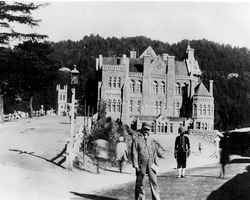The presence of cedar forests has played a major role in the evolution and development of various architectural forms. The wood extracted from the cidar tree is full of strength and can be used in multistoreys, can withstand long periods of weather corrosion, the wood is insect and termite resistant.
The 'Kathkuni' or 'Kathkundi' style of building is something unique to this part of the world. A mesh of interlocking horizontal cedar (locally, deodar) sleepers is created - and in this dressed or raw stone is packed. A singular characteristic is the absence of vertical members. With inherent elasticity, the design has an enormous seismic response - there have been instances when tremors have dislodged the stones from the frame, and later, have been hammered back into the intact mesh of wood houses and temples in the style are present in the districts of Shimla, Kullu & Kinnaur.
Walls of rammed earth are popular all over and in the treeless tracts of the Trans Himalaya, some stunning architecture has been created on seemingly insurmountable sites. The quality of dressed or carved stone has created remarkable temples, forts and residences. Fine slate, or slabs of quartzite have provided roofing material.
This came to be known as Hill Architecture.With the coming of the Europeans, Himachal added another dimension to its rich architectural heritage. It went on changing and the initial simple Swiss-type cottages/German country houses were outshone by architectural marvels in Elizabethan style of English renaissance or Gothic or the splendour of dressed stones and gray slate roof. All this assimilated well with the character of Shimla. It enhanced, not diminished the beauty of the hill station.
The state capital has some of the world's finest examples of British colonial architecture. Inspired by the Renaissance in England, is the greystone former Viceregal Lodge (now the Indian Institute of Advanced Study), the neo Gothic structures of the gaiety theatre and the former imperial Civil Secretariat (now the Accountant General's Office). There are the Tudor framed Barnes Court (now the Raj Bhawan), and the distinctive Vidhan Sabha and the secretariat of the government of Himachal Pradesh--




Comment with Facebook Box